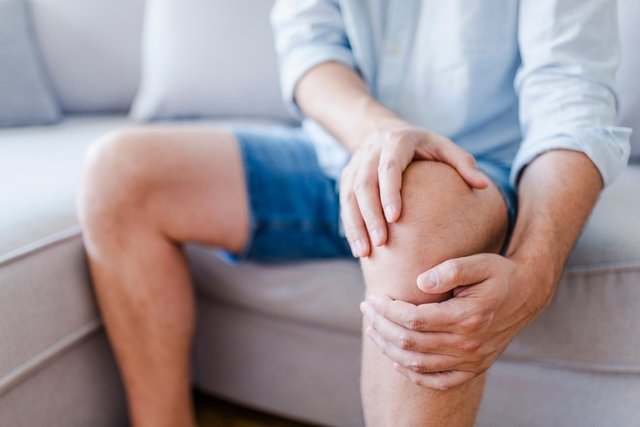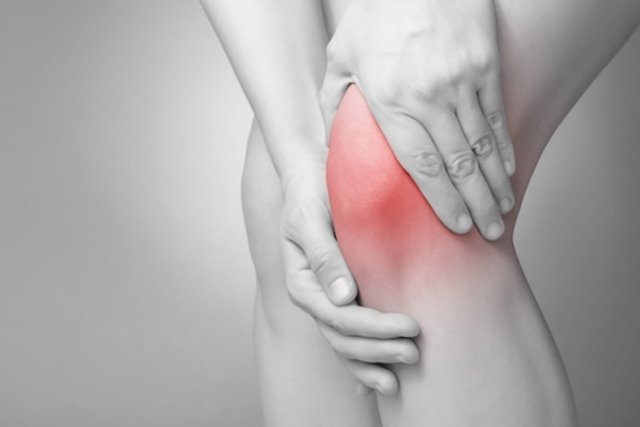Knee tendinitis, also known as patellar tendonitis or jumper’s knee, is an inflammation of the knee patella tendon that causes intense pain in the knee region, especially when walking or exercising.
Generally, knee tendonitis is more common in football, tennis, basketball players or runners, for example, due to excessive use of the extensor muscles (back of the thigh) for jumping and running.
However, tendinitis can also appear in elderly patients due to progressive wear and tear on the joint, and must be treated by an orthopedist. Learn about other causes of knee pain.

Symptoms of knee tendonitis
The main symptoms of patellar tendonitis may include:
- Pain in front of the knee;
- Pain that worsens when jumping or running;
- Knee swelling;
- Difficulty moving the knee;
- Feeling of stiff knees upon waking up.
In the presence of symptoms of patellar tendonitis, you should consult an orthopedist to confirm the diagnosis and initiate the most appropriate treatment.
How to confirm the diagnosis
The diagnosis of knee tendonitis is made by the orthopedist through evaluation of symptoms, health history and physical examination of the knee.
Make an appointment with the orthopedist in the region closest to you:
Taking care of your health has never been easier!
To confirm the diagnosis, the doctor may order imaging tests, such as X-rays, ultrasound or MRI, for example.
Classification of knee tendonitis
Patellar tendinitis can be classified into degrees according to the intensity of the symptoms and the moment they appear in:
- Grade I: Mild pain after activities;
- Grade II: Pain at the beginning of exercises, but without loss of performance during training;
- Grade III: Pain during and after physical activity, loss of performance in training;
- Grade IV: partial or total rupture of the patellar tendon.
Knee tendinitis can be cured through rest and application of ice, however, when these measures are not enough, it is recommended to start physiotherapy sessions to strengthen the knee muscles, relieve pain, and improve movement.
How the treatment is carried out
Treatment for knee tendinitis can be started at home by resting the affected leg, using an elastic band on the knee, and applying ice for 15 minutes 3 times a day, for example.
However, if the pain does not disappear within 10-15 days, it is important to consult an orthopedist to start taking analgesic and anti-inflammatory medications, such as Ibuprofen or Naproxen, to reduce local inflammation and relieve pain. See the main remedies for knee pain.
It is also recommended to undergo physiotherapy sessions to use electrotherapy devices, and perform stretching and strengthening exercises, which accelerate the healing process of the affected tendon.
In more serious cases, where knee tendonitis does not disappear with rest, medication and physical therapy after about 3 months, it may be necessary to undergo surgery to repair the damage caused to the knee tendon, but normally there is no need because physical therapy achieves great results.
Physical Therapy for Patellar Tendonitis
Electrotherapeutic equipment such as laser and ultrasound are recommended for pain relief and tissue regeneration.
It is necessary to strengthen the muscles of the entire leg, but especially the muscles on the front of the thigh, and global leg stretching exercises are also important to maintain a good balance between forces during everyday life. Discover some of the exercises to relieve knee tendinitis.
Mobilizing the patella is very important so that it can move freely over the joint, preventing it from becoming ‘glued’, making movement difficult.
See how physical therapy and nutrition can be helpful in treating tendonitis:
Bibliography
- SANTANA, Marcio José Santana, et al. Physiotherapy in the rehabilitation of patellar tendinopathy. Revista FAIPE Vol.5. 1 ed; 68-78, 2015

Sign up for our newsletter and stay up to date with exclusive news
that can transform your routine!
Warning: Undefined array key "title" in /home/storelat/public_html/wp-content/plugins/link-whisper-premium/templates/frontend/related-posts.php on line 12
Warning: Undefined array key "title_tag" in /home/storelat/public_html/wp-content/plugins/link-whisper-premium/templates/frontend/related-posts.php on line 13





